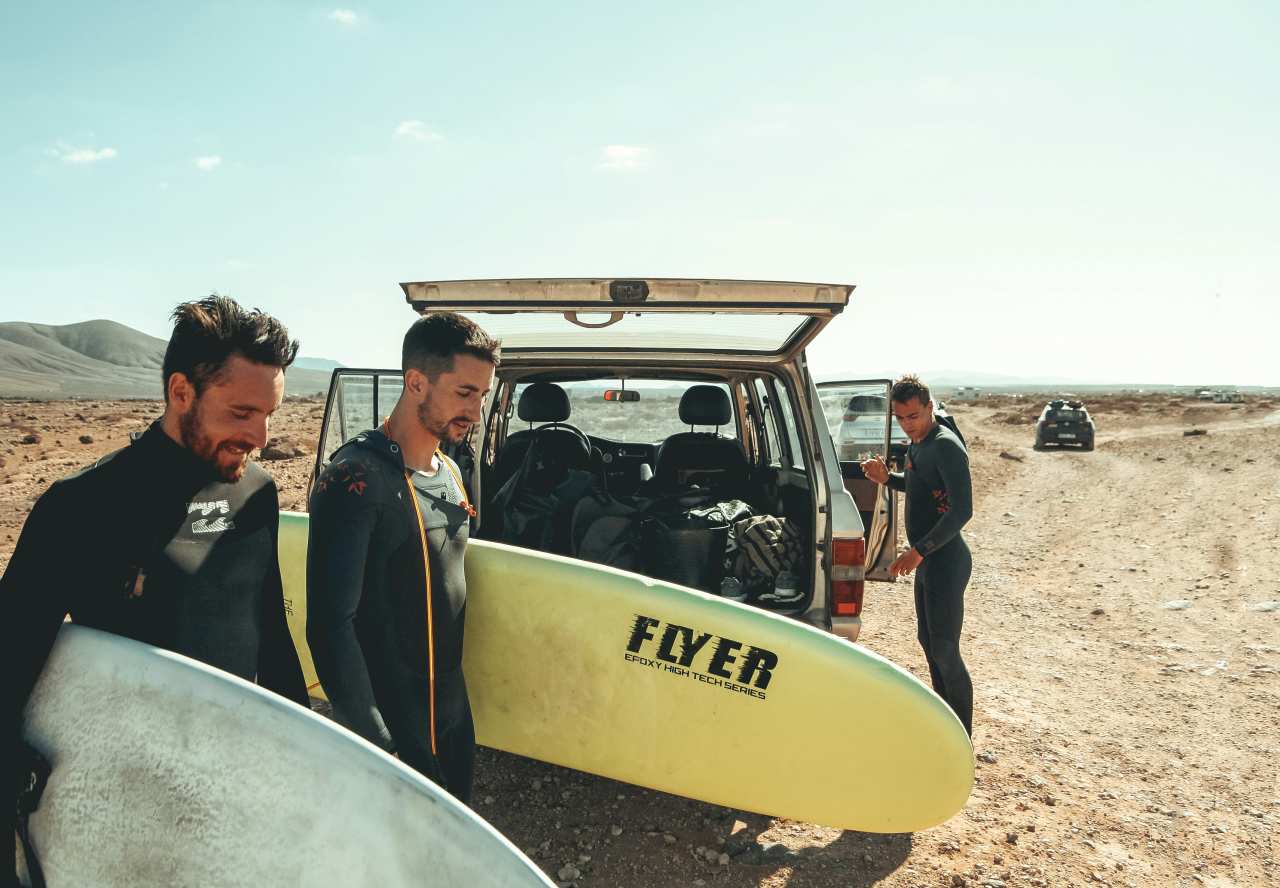If you’re looking for a heavy duty 4x4 wagon that can tackle the toughest off-road terrain and haul heavy loads with equal competence, there’s a handful of models derived from 4x4 one-tonne utes that can deliver.
Sharing the same rugged truck-style construction, with a wagon body mounted on a separate ladder-frame chassis, the local contenders in this four-way fight comprises Ford’s Ranger-derived Everest, Isuzu’s D-Max-based MU-X, Toyota’s HiLux-sharing Fortuner and Toyota’s 70 Series LandCruiser wagon (aka 76 Series) which comfortably predates its rivals having been launched in 2007.
Although the 76 Series five-seater does not offer a third row of seats like its rivals, it maintains a strong following with loyalists.
And its desirability has no doubt grown with the release of an updated range in late 2023, which for the first time offered buyers the choice of the venerable V8 turbo-diesel manual or new four-cylinder turbo-diesel automatic.
Given Toyota has been working around the clock to fill thousands of 70 Series orders for the traditional V8 manual, we thought it timely to revisit this much-loved drivetrain in wagon form to find out why it enjoys enduring popularity for both work and recreational roles.
Toyota Landcruiser 70 Series 2024: LC76 GXL + Diff Locks
| Engine Type | Diesel Turbo V8, 4.5L |
|---|---|
| Fuel Type | Diesel |
| Fuel Efficiency | 10.7L/100km (combined) |
| Seating | 5 |
| Price From | $78,430 - $90,090 |
Price and Features – Does it represent good value for the price? What features does it come with? 7/10?
7 / 10
The 76 Series wagon is available in work-focused Workmate grade, or premium GXL, as per our example. Equipped with the 4.5-litre turbo-diesel V8 and five-speed manual transmission, it has a list price of $83,900.

The GXL costs $8300 more than the Workmate V8 equivalent and for that extra spend you get an expanded menu of standard equipment including front and rear diff-locks, 16-inch alloy wheels and 265/70R16 tyres (with a full-size spare), wide front mudguards, wheel arch flares, LED front fog lights, aluminium side-steps and chrome bumpers.

Interior enhancements include keyless entry and central-locking, fabric seat and door trim, carpet flooring, power windows, front seat back-pockets, four-speaker audio and two USB-C ports (we’re surprised Toyota did not provide the usual choice of USB-A and USB-C ports).

These GXL features are in addition to standard equipment added as part of the recent 70 Series upgrade, including a redesigned front fascia with LED lighting including DRLs and auto high beam, 60/40-split rear seat (wagon only), multi-function steering wheel controls, a 4.2-inch driver’s multi-info display and upgraded multimedia with a 6.7-inch touchscreen display, digital radio and wired Apple and Android connectivity. Safety has also been upgraded with lane-keeping and speed sign recognition.
Design – is there anything interesting about its design? 7/10?
7 / 10
The 76 Series wagon has the shortest wheelbase of the four-model 70 Series range at 2730mm, which makes it the most responsive to steering input.
It also has the shortest overall length (4910mm) and in GXL form the tightest turning circle (13.2 metres) which can make life easier in tight situations, from busy car parks to challenging bush tracks.
Off-road credentials include 33 degrees approach and 23 degrees departure angles, plus 290mm of ground clearance. Curiously, Toyota does not publish a ramp break-over angle.

The interior is B for basic, in true 70 Series tradition, with seat fabrics and colours reminiscent of circa-1990s Toyotas.
The most noticeable differences between the four-cylinder auto and V8 manual cabins are that the V8 version has an extra pedal and misses out on the auto’s full-length centre console, which offers additional and much-needed storage space.
There’s ample headroom but that generosity does not extend to rear seat comfort, at least for tall people like me (186cm).

The entry pathway between the B-pillar and rear seat base cushion is narrow and, when sitting behind the driver’s seat in my position, my knees are pressing into the front seat’s backrest.
So, it’s not possible for two big blokes to sit one behind the other without the ‘one’ behind feeling squished.
Fortunately, the 60/40-split rear seat allows adjustment of backrest angles and for those seated in the centre there’s a nice flat floor with no transmission tunnel to straddle. However, the centre passenger’s back/backside are directly over the 60/40 split, which is quite a wide gap (about 15mm) that's intolerable for anything longer than short trips.
Rear shoulder room for three adults is also squeezy, so keep these rear seat issues in mind if planning an adventure for five.

Practicality – How practical is its space and tech inside? 7/10?
7 / 10
Our GXL V8 test vehicle’s 2355kg kerb weight and 3510kg GVM results in a Herculean payload rating of 1155kg.
It’s also rated to tow up to 3500kg of braked trailer and with its towering 7010kg GCM (or how much it can carry and tow at the same time), that means it can tow its maximum trailer weight while carrying its maximum payload, which is impressive.

These substantial load ratings make the 76 Series a popular choice for hardcore adventurers that need to carry a crew and everything else (including the kitchen sink) when venturing far off the beaten track for extended periods.
The absence of a third row of seating creates a spacious rear load area, accessed through asymmetric barn-doors, the larger of which carries the spare wheel/tyre.

The rear seat backrests can fold flat to provide more load volume and their base cushions can tumble forward to create even more space. The GXL’s load floor is carpeted and equipped with four anchorage hooks for securing load straps or cargo nets.
Cabin storage for personal items is in short supply, as the driver and front passenger only get a narrow and shallow bin (more like a document holder) at the base of each door, with a small bottle/cupholder in the passenger side bin.
There’s also a glove box, single small-bottle/cupholder next to the gearstick and a tiny console box between the seats.
Rear passengers only get mesh pockets on the front seat backrests, as there are no bins or bottle/cupholders in the rear doors.

There’s also no fold-down centre armrest, so no bottle/cupholders to be found anywhere. We reckon aftermarket cabin organisers would be popular purchases by 76 Series owners!
Under the bonnet – what are the key stats for its engine and transmission? 8/10?
8 / 10
Toyota’s (1VD-FTV) 4.5-litre turbo-diesel V8 produces 151kW at 3400rpm. More importantly, its 430Nm of torque is served at full strength across a vast 2000rpm-wide torque band between 1200-3200rpm. This showcases its remarkable flexibility for heavy load-carrying, towing and off-road slogging.

This engine is paired with the equally popular (H152F) five-speed manual transmission, which features an ultra-short first gear ideal for low-speed off-road driving or getting heavy loads moving. By comparison, the overdriven top gear provides long enough legs for economical cruising at highway speeds.
Its part-time, dual-range 4x4 transmission offers a 44:1 crawl ratio, combined with Toyota’s outstanding active traction control, automatic-locking front hubs and (standard on GXL) front and rear diff locks. This is a formidable off-roader.
Efficiency – what is its fuel consumption? What is its driving range? 8/10?
8 / 10
Toyota’s official average combined cycle consumption figure for the V8 manual is 10.7L/100km. The dash display was claiming 10.9 when we stopped to refuel at the completion of our 276km test, which comprised a mix of city, suburban, highway and dirt driving with a variety of occupant loads.

Interestingly, the dash readout was identical to our own 10.9 figure calculated from fuel bowser and tripmeter readings, which confirms the accuracy of the LandCruiser’s fuel calculations and the efficiency of its relatively large V8 in a vehicle weighing more than two tonnes in mostly urban driving.
So, based on our figures, it has a vast 'real world' driving range of more than 1100km from its huge 130-litre tank.
Driving - what’s it like to drive? 8/10?
8 / 10
The aluminium side-steps, along with handles on the A- (and B-) pillars, assist climbing aboard and all-around vision is good thanks to large glass areas, sizeable door mirrors and a reversing camera, although the rear seat headrests partly block vision through the central rear-view mirror.
It’s the best off-road driving position an adventurer could ask for, combining good comfort with a commanding view over the bonnet and out each side, which allows accurate vehicle placement in all terrain.
The ride quality is firm, as you’d expect in a vehicle that can legally haul more than seven tonnes, but supple enough to absorb bumps without jarring. This is aided by the relatively baggy sidewalls of the GXL’s tyres.
Old school recirculating-ball steering is low-geared and lightly weighted with ample free play off-centre to soften off-road blows, which is highly valued by loyal customers.
The wagon’s shorter wheelbase, tighter turning circle and shortest overall length than its 70 Series stablemates provides enhanced steering response and manoeuvrability, combined with four-wheel disc brakes giving ample stopping power.
Given the V8’s torque band is as wide and flat as Lake Eyre, it will accelerate smoothly in top gear from under 1000rpm, so there’s no need to shift your way through all five cogs from each standing start. In fact, for road use without a load, we always drive it like a three-speeder, using only first, third and fifth gears.
Noise levels are reasonably low in city and suburban driving. However, they do become more intrusive at highway speeds, when engine, tyre and wind noise combine to require raised voices, even though the overdriven top gear ensures a relatively low 2200rpm at 110km/h.
We also detected some squeaks and rattles emanating from the rear of the vehicle on bumpy roads, which suggested it was coming from the spare tyre mounted on the back door.
Warranty & Safety Rating
Safety – What safety equipment is fitted? What is its safety rating? 6/10?
6 / 10
No ANCAP rating for the wagon, as the single cab-chassis version is still the only 70 Series variant to have achieved five-stars and that was back in 2016.
And although the wagon has AEB with day/night pedestrian and daytime cyclist detection plus driver and front passenger front airbags, it misses out on side-curtain and driver’s knee airbags.
New safety features include lane-departure alert with steering assist, speed sign recognition and auto high-beam control. There are no ISOFIX child seat anchorages in the rear seat, but there are three top-tethers above the rear barn-doors.
Ownership – What warranty is offered? What are its service intervals? What are its running costs? 6/10?
6 / 10
The LandCruiser is covered by Toyota's five-year/unlimited km warranty.
Scheduled servicing is every six months/10,000km whichever occurs first.
Capped-price servicing of $525 applies for each of the first 10 scheduled services, which is a pricey $1050 per year or $5250 over five years.
Verdict
Life is full of compromises and the 76 Series wagon is no exception. The payback for accepting its minimal cabin storage, comfort-challenged rear seat, no ANCAP, high purchase price, high servicing costs etc is that you get a genuinely heavy duty 4x4 wagon with huge GVM/GCM ratings unmatched by its ute-derived rivals.
The V8 manual or four-cylinder auto have different characteristics but similar competence, with the manual obviously requiring more physical effort, so it comes down to personal preference. And we’re sure, given its long history, there’s plenty of emotional attachment driving the bulging V8 order book. Either way, with its enormous fuel tank and revered off-road prowess, this rugged and dependable wagon has a proven ability to take you and your crew deep into the wilderness – and get you home again.
Pricing Guides



.jpg)






































.jpg)
.jpg)

.jpg)

